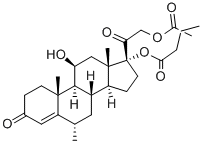| Company Name: |
MedChemexpress LLC
|
| Tel: |
021-58955995 |
| Email: |
sales@medchemexpress.cn |
| Products Intro: |
Product Name:Amebucort
CAS:83625-35-8
Purity:400RMB/1mg Package:>98%
|
|
| | Amebucort Basic information |
| Product Name: | Amebucort | | Synonyms: | Amebucort;Pregn-4-ene-3,20-dione, 21-(acetyloxy)-11-hydroxy-6-methyl-17-(1-oxobutoxy)-, (6α,11β)- (9CI) | | CAS: | 83625-35-8 | | MF: | C28H40O7 | | MW: | 488.61 | | EINECS: | | | Product Categories: | | | Mol File: | 83625-35-8.mol |  |
| | Amebucort Chemical Properties |
| Boiling point | 603.7±55.0 °C(Predicted) | | density | 1.20±0.1 g/cm3(Predicted) | | storage temp. | Store at -20°C | | solubility | Soluble in DMSO | | pka | 14.15±0.70(Predicted) |
| | Amebucort Usage And Synthesis |
| Originator | Amebucort,ZYF Pharm Chemical | | Manufacturing Process | (a) 100 g of 17,21-dihydroxy-6α-methyl-4-pregnene-3,20-dione and 10 g of
pyridinium tosylate are dissolved in 700 ml of dimethylformamide at room
temperature and under agitation, and the clear solution is diluted with 3.5 L of
toluene. The solution is then warmed up in a glycerin bath and, at a
temperature of 120°C, 1.2 L of toluene is distilled off to remove traces of
water. Under agitation, 240 ml of trimethyl orthoformate is gradually poured
into the hot reaction solution; the latter is reacted for 30 min and thereafter
additional toluene and other readily volatile reaction components are removed
by 1 hour of distillation. The mixture is combined with 120 ml of pyridine,
cooled to 60°C, and concentrated under vacuum at a bath temperature of
70°C. The mixture is then diluted with 400 ml of dimethylformamide, and the
solution is poured under agitation into 10 L of water, thus obtaining the
product in the form of a yellowish-white, crystalline precipitate. The mixture is
stirred for another 2 hours, vacuum-filtered, washed with water, and dried for
24 hours at 40°C in a vacuum over phosphorus pentoxide, thus obtaining
111.6 g of 17,21-(1-methoxyethylidenedioxy)-6α-methyl-4-pregnene-3,20-
dione, melting point 85-87°C.
(b) A 7-14 day old sweetwort slant with Curvularia lunata (NRRL 2380) is
freed of the supernatant with 3 ml of physiological sodium chloride solution,
and this supernatant is used to inoculate a 2-liter Erlenmeyer flask containing
500 ml of a nutrient solution of 2% glucose and 2% cornsteep, sterilized for
30 min at 120°C in an autoclave and adjusted to pH 6.5. After 60 hours of
shaking on a rotary shaker at 30°C, 250 ml of this germination culture is used
to inoculate the preliminary fermentor. A 20-liter prefermentor charged with
15 L of a nutrient medium of the same composition as the germination
medium and sterilized at 121°C and 1 bar gauge pressure is inoculated with
250 ml of germination culture. With the addition of silicone SH as the
defrother, germination is now conducted up to 29°C and 0.6 bar pressure
under aeration (15 L/min) and agitation (220 rpm) for 24 hours. The main
fermentor is inoculated with 1.5 L of this prefermentor culture. A 20-liter main
fermentor, filled with 13.5 L of a sterilized nutrient medium made up of 3%
cornsteep liquor and 0.7% glucose, adjusted to pH 5.5, is inoculated with 1.5
L of prefermentor culture. After an incubation phase of 12 hours under
prefermentation conditions, a sterile-filtered solution of 12.18 g of 17,21-(1-
methoxyethylidenedioxy)-6α-methyl-4-pregnene-3,20-dione in 130 ml of
dimethylformamide is added thereto and the mixture is further agitated and
aerated. 4 hours after addition of the substrate, the pH value of the culture
broth is set at pH 4.5 and held at this value. The pH 0.2 by automatic control
with 16% sodium hydroxide solution and 20% sulfuric acid until the end of the
fermentation. After a contact period of 51 hours, the microbiological
conversion is complete. The content of the fermentor is then treated in a
continuous centrifuge, and the culture filtrate as well as the centrifuged fungal
mycelium are extracted separately with methyl isobutyl ketone. The extracts
are combined and first concentrated in a forced-circulation evaporator to 1
liter at 40°C under vacuum, and then entirely evaporated to dryness in a 2-liter round flask on a rotary evaporator under vacuum at a bath temperature
of 40°C. The remaining oily residue is combined with 400 ml of hexane and
decanted after vigorous shaking. Subsequently, the residue is once again
combined with 400 ml of hexane and agitated at room temperature for 2
hours. The now completely crystallized residue is vacuum-filtered, washed
with 100 ml of hexane, and dried for 4 hours at 60°C in a vacuum. Yield: 9.9
g of 17-acetoxy-11β,21-dihydroxy-6α-methyl-4-pregnene-3,20-dione which,
after recrystallization from acetone-diisopropyl ether, melts at 192-194°C.
A solution of 1.0 g of 17-acetoxy-11β,21-dihydroxy-6α-methyl-4-pregnene-
3,20-dione in 20 ml of pyridine is combined with 3 ml of butyric anhydride
and stirred at room temperature for 2 hours. The reaction solution is then
allowed to flow into 150 ml of cooled 8% sulfuric acid and agitated for another
5 hours; the product, initially precipitated in oily form, becomes completely
crystallized. The product is vacuum-filtered, washed with water, and dried for
6 hours at 80°C in a vacuum. For purifying purposes, the crude product is
recrystallized from acetone-diisopropyl ether, thus obtaining 940 mg of 17-
acetoxy-21-butyryloxy-11β-hydroxy-6α-methyl-4-pregnene-3,20-dione,
melting point 98-120°C. | | Therapeutic Function | Antiinflammatory, Antiallergic |
| | Amebucort Preparation Products And Raw materials |
|